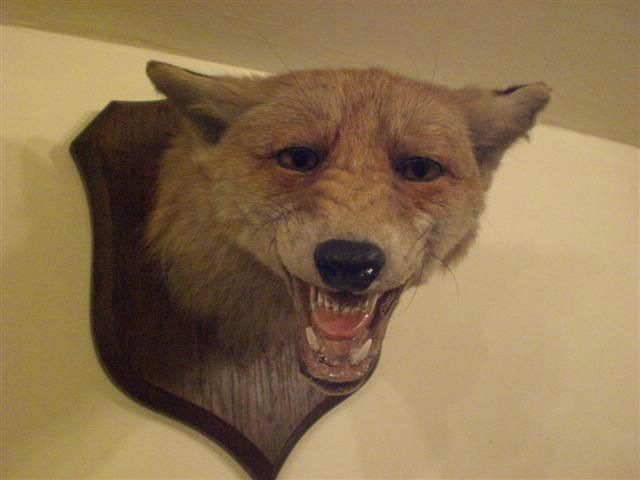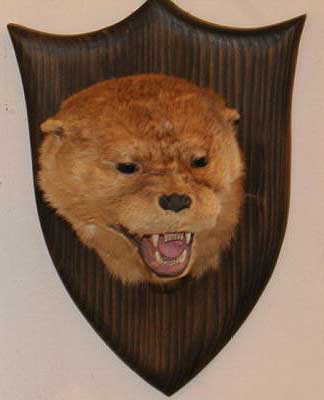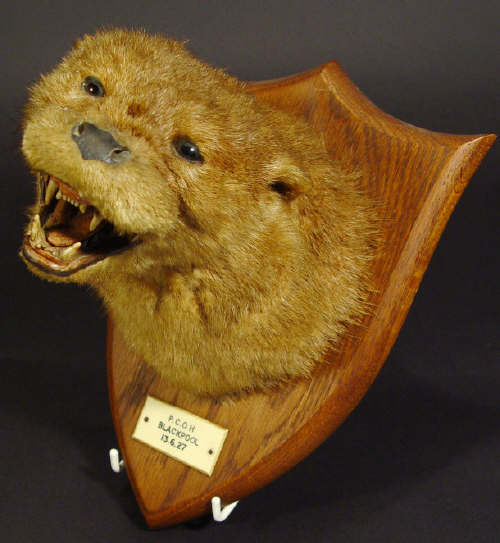Taxidermy4Cash.com
Taxidermy in the UK
We are always very interested in Purchasing Victorian Taxidermy, please respond via this on-line form of what you have for sale. HERE
This is just a compilation of imagery collected and donated over the years. Hope you enjoy them. We have never fully understood the rationale behind collecting such items. Our own personal preference would be to see the entire animal. We do however recognise that this practice existed and as such have dedicated a page to this type of taxidermy..
Victorian & Edwardian Taxidermy.
Hunting in Africa / Asia
![pstiger [640x480] copy.jpg](pstiger [640x480] copy.jpg)
Tigers head by the Victorian artist Peter Spicer in close up.
As the European demand for ivory, ostrich feathers and hides from southern Africa increased from the middle of the eighteenth century onwards, the Cape Colony and the eastern Cape became the object of attention from both naturalists and hunters. One of the most distinguished of these was the Swedish botanist and pupil of Linnaeus, Carl Peter Thunberg, who visited the Cape three times between 1772 and 1775. He helped to inaugurate a steady stream of hunters' tales cum travelogues which were to document the steady retreat of wildlife (and extinction of certain species) in southern Africa throughout the nineteenth century. This provided the impetus for game conservation laws elsewhere in Africa from the late nineteenth century onwards.

African Elephant head during the Edwardian period.

Hippo head by Gerrards.
![CapeBuffalo[1]rw [640x480].JPG](CapeBuffalo[1]rw [640x480].JPG) Victorian Cape Buffalo head by Rowland Ward.
Victorian Cape Buffalo head by Rowland Ward.
François Le Vaillant was born in 1753 in Dutch Guinea where his father, a well-to-do merchant, held the position of French consul. He inherited from his father a love of travel and ornithology. In 1777 he was so impressed by visiting the then very popular cabinets of natural history in Paris that he decided to go overseas to collect specimens. In 1793 he was imprisoned by the Jacobins (perhaps because of his family's close connections with the ancien régime) and escaped death only through the downfall of Robespierre that year. He died in comparative obscurity in 1824.
 Victorian Black Rhino head by Rowland Ward.
Victorian Black Rhino head by Rowland Ward.
 Victorian African Hunting Dog head by Rowland Ward.
Victorian African Hunting Dog head by Rowland Ward.
![rwlhead[1].JPG](rwlhead[1].JPG) Victorian Leopard head by Rowland Ward.
Victorian Leopard head by Rowland Ward.
However, his scientific work also cost him the trust of another group: zoologists. Although there is no doubting his enthusiasm (he was responsible for bringing the first specimen of a giraffe to the Jardin des Plantes) he was widely suspected then and after his lifetime of fabricating research findings, particularly in his specialism, ornithology. In this, he may have been taken in by a Paris taxidermist who was skilled in the production of composite birds of different species. Having been shown spurious specimens, purportedly from southern Africa, Le Vaillant may have felt compelled to assert that he had already seen them. For example, he claimed to have found a species of cuckoo (Cuculus niger), which is native to Bengal, not to southern Africa.
 Victorian Wilderbest head by Rowland Ward.
Victorian Wilderbest head by Rowland Ward.
 Victorian Hyena head by Rowland Ward.
Victorian Hyena head by Rowland Ward.
 Victorian Tiger head by Rowland Ward.
Victorian Tiger head by Rowland Ward.
![jebbabuffward [640x480].jpg](jebbabuffward [640x480].jpg) Victorian Jebba Buffalo head by Rowland Ward.
Victorian Jebba Buffalo head by Rowland Ward.
It is known that the male of the species is black and the female grey. Le Vaillant took them for two distinct species and invented a black female companion for the male and a grey female companion for the male. He claimed in the second volume to have found the species in Great and Little Namaqualand. This was not the only instance where his claims were later found incredible.

The process of mounting a Lion.
Theodore Roosevelt. African game trails: an account of the African wanderings of an American hunter-naturalist. London: John Murray, 1910 Theodore Roosevelt (1858-1919), who served two terms as President of the United States at the beginning of the twentieth century, was a man for whom hunting was not just a recreational pursuit but an integral part of the image which he sought to project. He believed that hunting fostered the martial virtues needed by the United States in its new role as an imperial power. Following the collapse of the remnants of the Spanish empire in the late 1890s, the United States for the first time acquired overseas colonies. As a soldier and hunter, Roosevelt sought to personify this change.
![Kodiakbear[1].JPG](Kodiakbear[1].JPG)
Alaskan Kodiak Bear. This is how items would have been collected historically. You would have walked in to the wilderness harvested the animal, skinned it and carried it out. This is to illustrate how most mammal mounts begin life.
 Bengal Tiger likely to be by Rowland Ward
Bengal Tiger likely to be by Rowland Ward
Roosevelt was an educated and cultured man, who always carried a volume of serious literature or history (bound in pigskin) when he went hunting. The contradictions of his character are manifest in African game trails. He and his son Kermit embarked on an eleven month safari in the East Africa Protectorate in 1909, after the conclusion of his second term. The ostensible purpose of the visit was to collect specimens for the Smithsonian Institution and for the Natural History Museum in New York. During his presidency, Roosevelt had shown a genuine interest in conservation, initiating America's national parks programme. However, his real passion lay elsewhere. Although he states in the book that, 'Game butchery is as objectionable as any other form of wanton cruelty or barbarity', he admitted in a private letter that he had, 'killed most of the things that I specially desired to kill - the lion and rhinos. Indeed, I simply had to kill them'. This inner compulsion to prove his courage by killing dangerous animals at close quarters is manifest in the book. By his own admission, he shot 512 heads of game during the safari, far more than were needed for specimen gathering, often with disregard for the rarity of the species.

Bengal Tiger Rug by Van Ingen of Mysore. Never really fully understood the attraction of such items

Hyena head by Gerrards.

Leopard head by Gerrards.
The keen hunter Sir Frederick Jackson, Deputy Commissioner for the East Africa Protectorate, who had waived the hunting regulations for Roosevelt, was critical of Roosevelt's conduct on the safari. It was, he said:
a matter of great regret … that [Roosevelt] was utterly reckless in the expenditure of ammunition, and what it entailed in the matter of disturbing the country; and that he so exceeded reasonable limits, in certain species, and particularly the white rhinoceros, of which he and Kermit killed nine.
The colonial adventurer, hunter and naturalist Frederick Courteney Selous, who accompanied Roosevelt, was convinced by this experience that more stringent measures of conservation were necessary.
The frontispiece portrait shows the Roosevelts, father and son, astride a dead buffalo, a species endangered by rinderpest and hunting.

Bengal Tiger Rug by Van Ingen of Mysore. Thanks Jeff

Bengal Tiger by Van Ingen of Mysore.

Bengal Tiger by Van Ingen of Mysore.

Hunting Dog by Van Ingen of Mysore.

Tiger by Rowland Ward.
FOX HUNTING HISTORY
Many Greek- and Roman-influenced countries have long traditions of hunting with hounds. Hunting with Agassaei hounds was popular in Celtic Britain, even before the Romans arrived, with their Castorian and Fulpine hound breeds which they used to hunt. Norman hunting traditions were brought to Britain when William the Conqueror arrived, along with the Gascon and Talbot hounds.
 Victorian Fox head by H Murray of Carnforth
Victorian Fox head by H Murray of Carnforth
Foxes were referred to as beasts of the chase by medieval times, along with the red deer (hart & hind), martens, and roes, but the earliest known attempt to hunt a fox with hounds was in Norfolk, England, in 1534, where farmers began chasing down foxes with their dogs for pest control. The first use of packs specifically trained to hunt foxes was in the late 1600s, with the oldest fox hunt likely to be the Bilsdale in Yorkshire. By the end of the seventeenth century, deer hunting was in decline. The Inclosure Acts brought fences to separate open land into fields, deer forests were being cut down, and arable land was increasing. With the onset of the Industrial Revolution, people began to move out of the country and into towns and cities to find work. Roads, rail, and canals split hunting countries, but also made hunting accessible to more people. Shotguns were improved during the nineteenth century and game shooting became more popular. Fox hunting developed further in the eighteenth century when Hugo Meynell developed breeds of hound and horse to address the new geography of rural England.
To protect pheasants for the shooters, gamekeepers culled foxes almost to extirpation in many areas, which caused the huntsmen to improve their coverts to preserve their quarry The Game Laws were relaxed in 1831, which meant that anyone could obtain a permit to take rabbits, hares, and game birds.
 Fox mask by Peter Spicer. So typical of the hundreds, if not thousands produced by this firm during their tenure.
Fox mask by Peter Spicer. So typical of the hundreds, if not thousands produced by this firm during their tenure.
![lot570 [640x480].jpgg](lot570 [640x480].jpg) Victorian Fox head by Rowland Ward
Victorian Fox head by Rowland Ward
In Germany, hunting with hounds was first banned on the orders of Hermann Goering on July 3, 1934, one of the first laws to be introduced by the Nazis when they came to power in 1933. In 1939, the ban was extended to cover Austria after Germany's annexation of the country. Bernd Ergert, the director of Germany's hunting museum in Munich, said of the ban, "The aristocrats were understandably furious, but they could do nothing about the ban given the totalitarian nature of the regime."
Otter Hunting

Murray Otter mask. Thanks Jeff
Otters were once hunted for their fur and were thought of as a pest, competing with fishermen for fish. Otter-hunting with hounds was banned in the 1960s. In spite of these pressures, otters were widespread throughout Britain and the population remained steady until the 1950s when it declined rapidly. They are now rare or absent from lowland areas of England such as the midlands and the south.
 Otter Mask by Peter Spicer
Otter Mask by Peter Spicer
The main reasons for the dramatic reduction in the number of otters has been disturbance and pollution. Since the 1950s riverside habitats have been drastically changed by farming and building techniques in addition to clearing for drainage. In other words, riverbanks have become far too tidy for the secretive otter. Watersports have also added to the disturbance of waterways.
Pollution of freshwater habitats has probably had the greatest impact on otters. The use of pesticides was greatly increased during the 1950s, particularly aldrin and dieldrin. These were washed off the land into rivers etc. and contaminated fish with tiny amounts of poison. Even though the fish may not be affected, the poison gradually accumalates in an otter eating a lot of fish, resulting in its death. Although most of these pesticides have been restricted since 1962, otter numbers have not increased a great deal.

Victorian Otter head by Peter Spicer.
Otters have been protected by law since 1981 but a major threat to them now is traffic on the roads. Almost 70 per cent of otters found dead in Britain are killed on the roads. Most of these are males, following established routes through their territories which have been crossed by busy new roads.
Hare Coursing
Formal coursing
Hare coursing is the pursuit of hares with Greyhounds and other sighthounds, which chase the hare by sight and not by scent. It is a competitive sport, in which dogs are tested on their ability to run, overtake and turn a hare, rather than a form of hunting aiming at the capture of game. It has a number of variations in its rules around the world. Informal coursing, can be a true form of hunting, often conducted to kill game or vermin, mainly for food, occasionally as a form of gambling.
Coursing is a long established and almost universal hunting technique, practiced historically with Greyhounds, other sighthound breeds, or with lurchers, which are cross bred sighthounds and working breeds. The sport grew in popularity in the UK and Europe during the 19th century, but has since experienced a decline due in part to the introduction of Greyhound racing and betting.
![spicerhareshead[1].jpg](spicerhareshead[1].jpg)
Victorian Hare's head by Peter Spicer.
Coursing the hare, Francis Barlow, 1686
Whether for sporting or hunting purposes, hare coursing was in the UK and Europe historically restricted to landowners and the nobility, who used sighthounds, the ownership of which was at certain historic times prohibited among the lower social classes. The oldest documented description of hare coursing is the work Kynegetikos (Greek), otherwise known as Cynegeticus (Latin), which was written by Arrian circa 180 AD. This work, known from its first complete English translation as On Coursing 1831, by William Dansey, was considered by its original author as a necessary addition to the classic work of the same name Cynegeticus (On Hunting), scent hunting, by Xenophon. Arrian felt compelled to describe the sight hunt and sighthounds because the Ancient Greeks only knew the scent hunt. It is from Arrian that the most famous quote on the sporting fairness of coursing originates "... true huntsmen do not take out their hounds to catch the creature, but for a trial of speed and a race, and they are satisfied if the hare manages to find something that will rescue her".
 Victorian Hares Head by Bill Cox of Liverpool.
Victorian Hares Head by Bill Cox of Liverpool.
The competitive version of hare coursing was given definitive form in the UK when the first complete set of English rules was drawn up in the reign of Elizabeth I by Thomas Duke of Norfolk, providing for a pursuit of no more than two hounds, a headstart termed "Law" to be given to the hare for a fair run, and for the manner of awarding points on "Speed", "Go-bye", "Turn", "Wrench", "Kill" & "Trip", to judge the dogs' performance. The first modern coursing club was established at Swaffham in 1776 and the National Coursing Club was founded to regulate the sport in 1858. During the 1800s, coursing crossed the class divide, and reached its peak of popularity, with more than 150 coursing clubs in Britain some attracting up to 80,000 people. By the late 19th century, hare coursing had become a predominantly working class sport.
Coursing declined during the 20th century, notably due to the development of urban Greyhound racing in the 1920s, and there were less than 30 coursing clubs in the UK by 2000.

Victorian Stag's head by Rowland ward.
Taxidermy4Cash does not undertake taxidermy, rather we are collectors of
other people’s work, both current and historical we also offer web hosting,
a search engine submission service and increasingly one of the larger
article resource banks on the net. So if your keen to learn about Taxidermy
etc, then you know where to look.
We are always interested to here about new resource, if you feel a resource
should be listed here then please contact us.
|
ITEMS
WANTED. Please respond via this on-line form HERE
with a description of what you have for sale.
[HOMEPAGE]
Taxidermy Links.
Please double click on the Taxidermy link icon below.
Taxidermy
Links
|
|
![pstiger [640x480] copy.jpg](pstiger [640x480] copy.jpg)
![pstiger [640x480] copy.jpg](pstiger [640x480] copy.jpg)







![jebbabuffward [640x480].jpg](jebbabuffward [640x480].jpg)









![lot570 [640x480].jpgg](lot570 [640x480].jpg)



![spicerhareshead[1].jpg](spicerhareshead[1].jpg)

